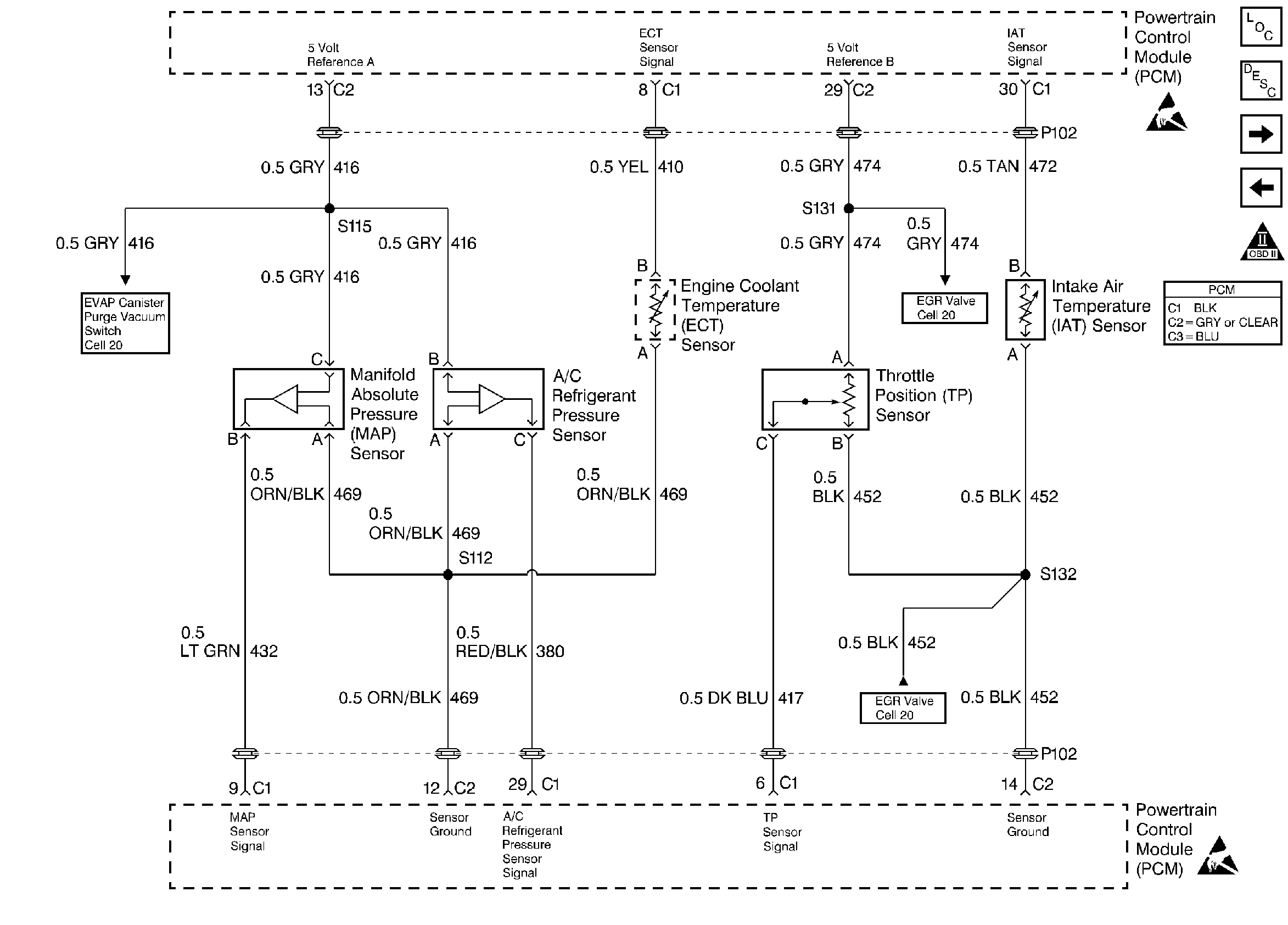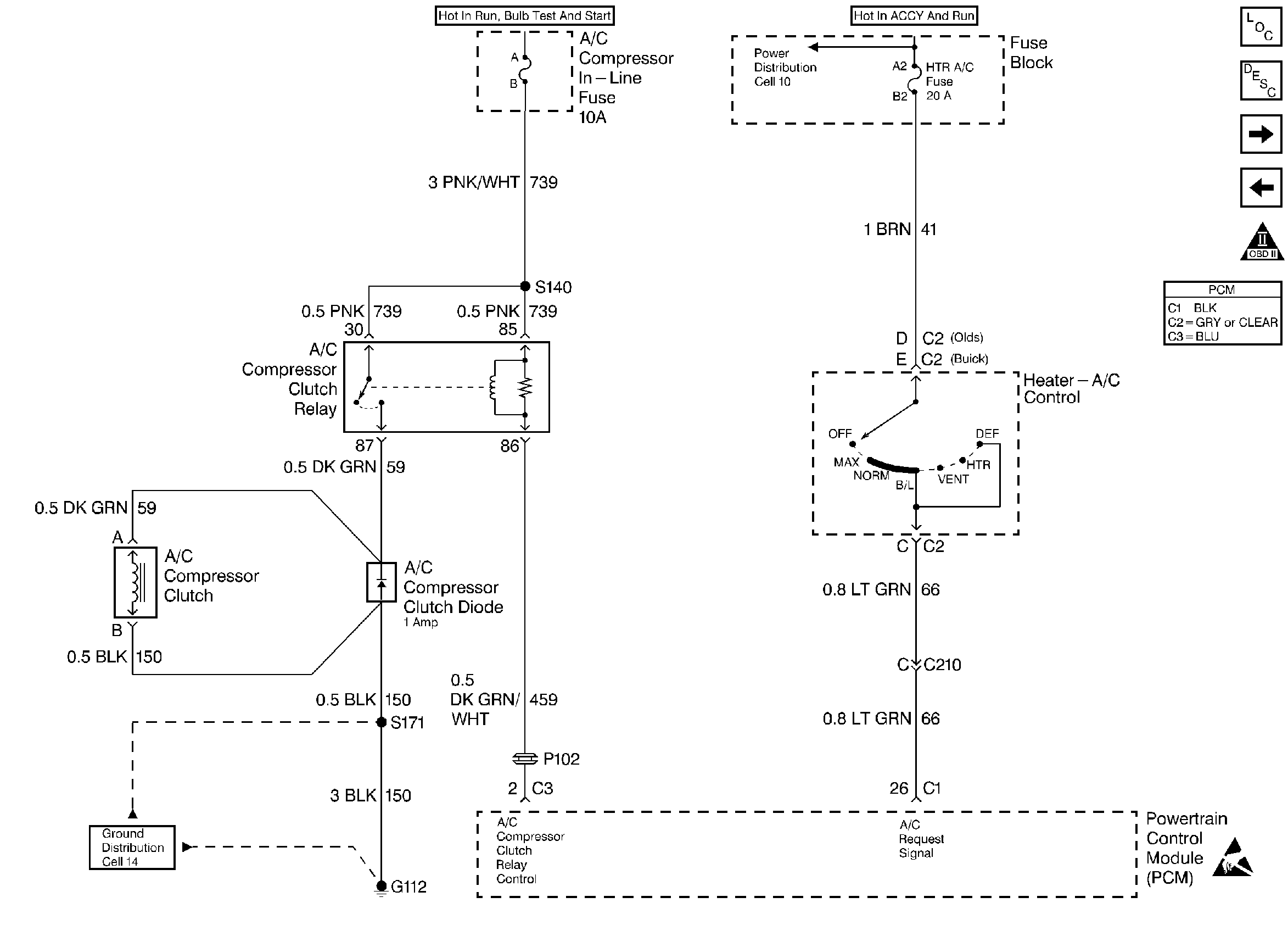Refer to
Engine Data Sensors

. Refer to
A/C Controls

.
Circuit Description
The PCM receives an A/C request signal from the A/C selector switch. When A/C is requested, the Powertrain Control Module (PCM) provides a ground path to the A/C clutch relay control circuit. When the relay circuit is grounded, the A/C compressor clutch relay is energized. The PCM delays grounding the relay circuit for 0.3 second, so the PCM can adjust the engine idle RPM for the additional load.
The PCM will temporarily de-energize the A/C compressor clutch relay for one or more of the following conditions:
| • | A hot engine restart. |
| • | A wide open throttle, or TP sensor over 90 percent. |
| • | Engine RPM more than 6000 RPM. |
| • | During an Idle Air Control (IAC) valve reset. |
| The A/C compressor clutch relay will remain de-energized when one or both of the following conditions exist: |
| • | A DTC P0530 is set. |
| • | There is no A/C request signal to the PCM. |
| Refer to A/C diagnosis for more information on the A/C refrigerant systems. |
Diagnostic Aids
| • | If DTC P0530 is set, do not use this table. |
| • | An A/C refrigerant pressure outside the range of 43 to 428 psi, will cause the A/C compressor clutch to be disabled by the PCM. Observe the A/C refrigerant pressure parameter on the scan tool for 2 minutes with the engine idling and A/C ON. If pressure goes out of range, refer A/C Diagnosis. |
Test Description
Number(s) below refer to number(s) on the diagnostic table.
-
The Powertrain OBD System Check prompts the technician to complete some basic checks and store the freeze frame and failure records data on the scan tool if applicable. This creates an electronic copy of the data taken when the fault occurred. The information is then stored on the scan tool for later reference.
-
The PCM will only energize the A/C relay when the engine is running. This test will determine if the relay or control circuit is faulty.
-
By disconnecting the relay, the system can be divided into two sections. If the clutch does not disengage, the fault lies on the compressor side of the system.
-
A test light that does not illuminate indicates that the A/C compressor clutch relay is faulty.
-
Determines if the system is normal or if the A/C refrigerant pressure sensor reading is out of range.
-
Determines if the signal is reaching the PCM from the A/C control panel. The signal should only be present when an A/C mode or defrost mode has been selected.
-
This step determines if the A/C refrigerant pressure sensor is out of range causing the A/C compressor clutch to be disabled or if the A/C charge is to low to allow A/C operation.
-
Replacement PCM's must be reprogrammed. Refer to latest Techline information for programming procedures.
-
Connecting circuit's 59 and 459 together bypasses the PCM's control of the A/C compressor clutch. An A/C compressor clutch that fails to engage at this point indicates that the fault is in circuit 59, the compressor coil or compressor coil ground circuit.
-
With the engine running and the A/C relay commanded ON, the PCM should ground the A/C relay control circuit. This will also illuminate the test light.
-
If no faults have been found at this point, refer to Diagnostic Aids for additional checks and information.
Step | Action | Value(s) | Yes | No |
|---|---|---|---|---|
Was the Powertrain On-Board Diagnostic (OBD) System Check performed? | -- | |||
2 | Install a scan tool. Was DTC P0530 set? | -- | Go to DTC tables first | |
Turn the ignition switch ON, with the engine OFF. Is the A/C compressor clutch engaged? | -- | |||
Disconnect the A/C relay. Does the A/C compressor clutch disengage? | -- | |||
5 |
Does the A/C compressor clutch cycle ON and OFF with the selector switch? | 85°C (185°F) | ||
With a test light connected to B+, probe the A/C relay control terminal. Does the test light illuminate? | -- | |||
7 | Disconnect the A/C clutch electrical connector. Does the A/C compressor clutch disengage? | -- | ||
Are the High side pressures within the specified value of each other? | 20 psi | |||
Turn the A/C ON and OFF. Does the scan tool indicate when the A/C is requested and not requested correctly? | -- | |||
10 | Check the A/C compressor clutch relay control circuit for a short to ground and repair as necessary Was a repair necessary? | -- | ||
11 | Replace the A/C compressor clutch relay. Is the action complete? | -- | -- | |
12 | Repair the short to B+ in the A/C compressor clutch ignition feed circuit. Is the action complete? | -- | -- | |
13 | Replace the faulty A/C compressor clutch assembly. Is the action complete? | -- | -- | |
14 |
Does the DVM read the specified value? | B+ | ||
15 | Turn the ignition switch ON, with the engine OFF. Is the A/C Highside value between the specified values? | 40-430 psi | ||
16 |
Does the test light turn ON and OFF when the A/C selector switch is cycled? | -- | ||
17 | Check A/C request circuit connector to PCM for poor connection and repair if necessary. Was a repair necessary? | -- | ||
18 | Replace the A/C refrigerant pressure sensor. Is the action complete? | -- | -- | |
19 | Repair the open or poor connection in the A/C refrigerant pressure sensor ground. Is the action complete? | -- | -- | |
20 |
Does the test light illuminate on both circuits? | -- | ||
Are the High side pressure within the specified value of each other? | 20 psi | Go to Section 1B | ||
Replace the PCM. Is the action complete? | -- | -- | ||
23 | Repair the signal from the A/C selector switch (refer to Section 8A-64). Is the action complete? | -- | -- | |
Connect a jumper between the A/C relay ignition feed terminal and the A/C compressor clutch feed terminal. Does the A/C compressor clutch engage? | -- | |||
25 | If the test light did not illuminate on the A/C relay battery feed terminal, check for a short to ground in the A/C compressor clutch ignition feed circuit or for a faulty A/C compressor clutch diode and repair as necessary. Was a repair necessary? | -- | ||
Does the test light illuminate? | -- | |||
27 |
Does the test light illuminate? | -- | ||
28 | Repair the open battery or ignition feed circuit to the A/C relay. Is the action complete? | -- | -- | |
29 | Connect the test light to ground and again probe the compressor clutch relay control terminal. Did the test light illuminate? | -- | ||
30 | With a test light connected to B+, probe the A/C compressor clutch ground circuit. Does the test light illuminate? | -- | ||
31 | Repair the open in the A/C compressor clutch ignition feed circuit. Is the action complete? | -- | -- | |
32 | Check the A/C compressor clutch relay control circuit for a short to voltage and repair as necessary. Was a repair necessary? | -- | ||
33 | Check the A/C compressor clutch relay control circuit for an open or poor connection and repair as necessary. Was a repair necessary? | -- | ||
34 | Replace the A/C compressor clutch coil. Is the action complete? | -- | -- | |
35 | Repair the open or poor connection in the A/C compressor clutch ground circuit. Is the action complete? | -- | -- | |
Does the A/C compressor clutch cycle ON and OFF? | System OK Refer to Diagnostic Aids |
